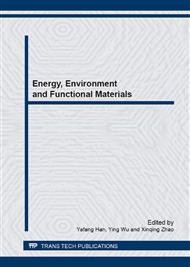[1]
WARMING P O F G, POLICY E, Fuel for Thought (October-Mid December 2008), Energy & Environment. 20 (2009)215-278.
Google Scholar
[2]
C. H. Liu, T. H. Ko, Y. K. Liao, Effect of carbon black concentration in carbon fiber paper on the performance of low-temperature proton exchange membrane fuel cells. Journal of Power Sources 178 (2008) 80–85
DOI: 10.1016/j.jpowsour.2007.11.103
Google Scholar
[3]
M. Mathias, J. Roth, J. Fleming, Z. Qi. Diffusion media materials and characterization, in :W. Vielstich, A. Lamm, H. A.Gasteiger(Eds), Handbook of fuel cells—Fundamentals, technology and applications, New York, 2003, p.517–537.
Google Scholar
[4]
Weber A Z, Improved modeling and understanding of diffusion-media wettability on polymer-electrolyte-fuel-cell performance, Journal of Power Sources. 195 (2010)5292-5304.
DOI: 10.1016/j.jpowsour.2010.03.011
Google Scholar
[5]
Priyanka H, Maheshwari, R.B. Mathur, T.L. Dhami, The influence of the pore size and its distribution in a carbon paper electrode on the performance of a PEM Fuel cell, Electrochimica Acta. 54 (2008) 655-659.
DOI: 10.1016/j.electacta.2008.07.029
Google Scholar
[6]
Mathias M F, Roth J, Fleming J et al, Diffusion media materials and characterisation. Handbook of fuel cells, 2010.
Google Scholar
[7]
Yang J B, Ling L C, Liu L, et al, Preparation and properties of phenolic resin-based activated carbon spheres with controlled pore size distribution, Carbon. 40(2002)911-916.
DOI: 10.1016/s0008-6223(01)00222-6
Google Scholar
[8]
Mathur R B, Maheshwari P H, Dhami T L, et al, Processing of carbon composite paper as electrode for fuel cell, Journal of power sources. 161(2006)790-798.
DOI: 10.1016/j.jpowsour.2006.05.053
Google Scholar
[9]
Zhe Tanga, Chee Kok Pohb, Zhiqun Tianb, Jianyi Linb, How Y. Ngc, Daniel H.C. Chuaa, In situ grown carbon nanotubes on carbon paper as integrated gas diffusion and catalyst layer for proton exchange membrane fuel cells, Electrochimica Acta. 56(2011) 4327-4334.
DOI: 10.1016/j.electacta.2011.01.035
Google Scholar
[10]
Savage G, Applications of Carbon-carbon Composites,Springer Netherlands, 1993.
Google Scholar
[11]
Thostenson E T, Ren Z, Chou T W, Advances in the science and technology of carbon nanotubes and their composites: a review, Composites science and technology. 61(2001), 1899-1912.
DOI: 10.1016/s0266-3538(01)00094-x
Google Scholar


